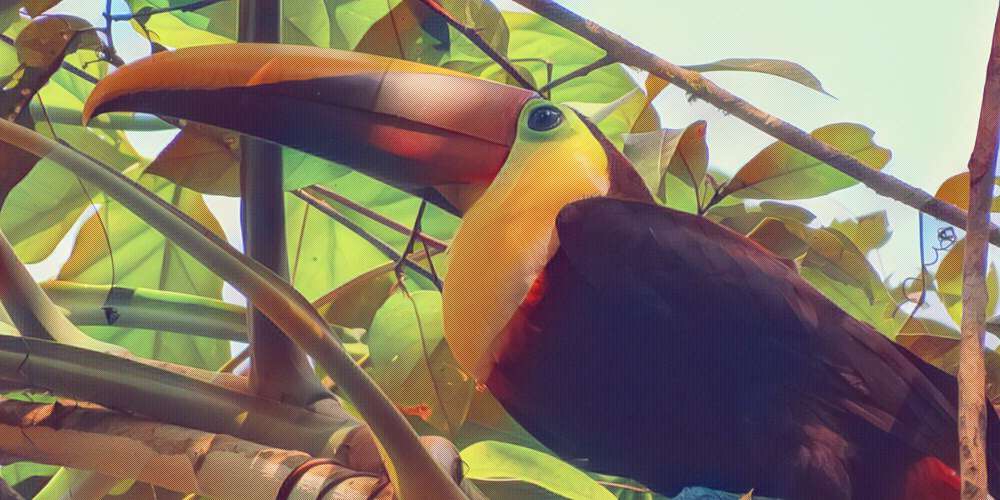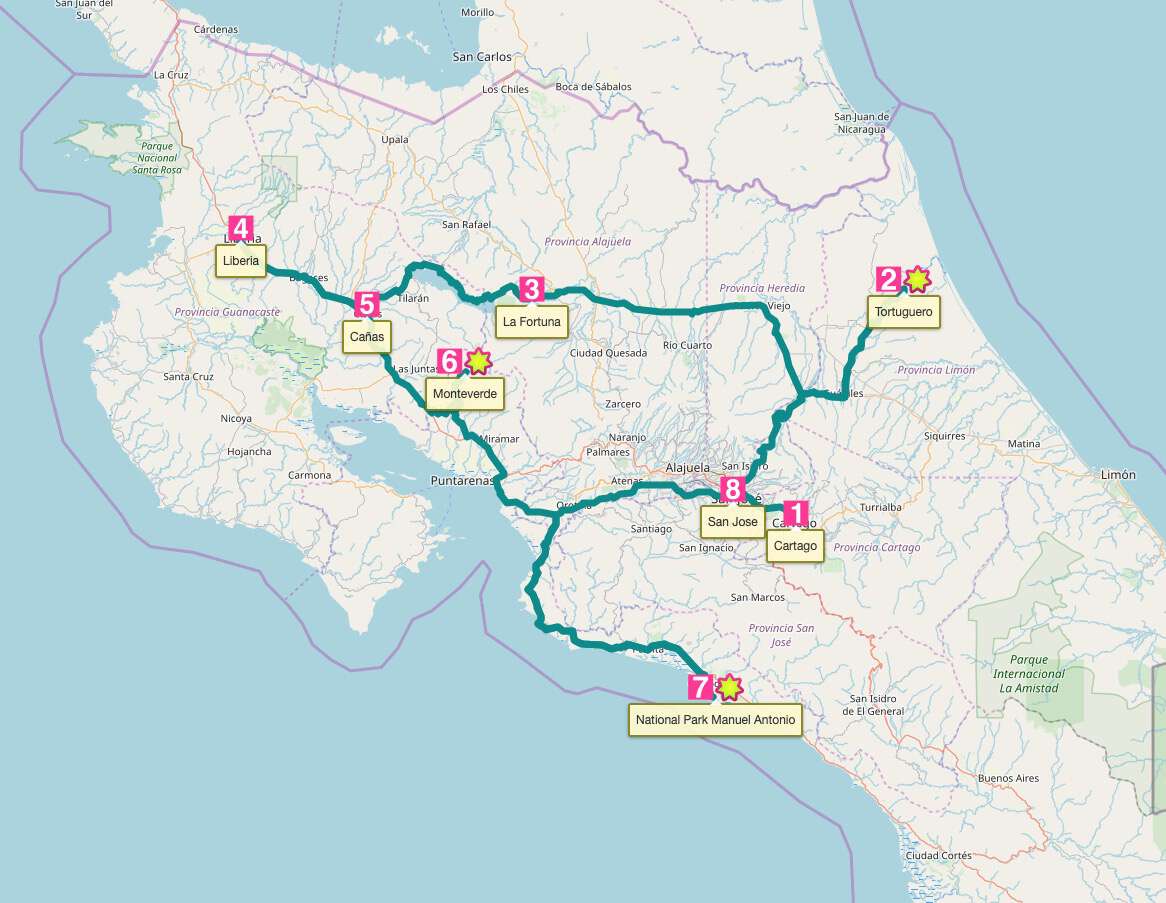

You intend to travel to Costa Rica? Maybe even as a self-driver with a rental car? Then this is the right place for you. The round trip presented here support you in planning your own trip.
On this trip you will visit 5 spectacular national parks and probably see sloths, iguanas, crocodiles, birds in all colours and all kinds of monkeys. And if you like, you can also visit cultural sites such as the former capital Cartago.
Costa Rica is considered safe and the road network is well developed. The country is perfect for a self-organized trip by rental car. Below I'll give you some tips on choosing a rental car and suitable navigation apps.
And you don't necessarily have to speak Spanish. English almost always gets you through well. Or you simply improvise with your hands and feet.
Recommended duration of the trip: 14 days
Number of places of accommodation: 8
Maximum travel time between overnight stays: 3:30 hours
Travel time: We made the trip in April during the dry season, which runs from December to April. A Costa Rica holiday is also possible during the rainy season. Because also in the rainy season it rains mostly only 2-3 hours and remains dry the rest of the day.

We relax in the afternoon at the Jardin Botanico Lankester.
The garden was founded in 1910 by the Englishman Charles H. Lankester and is maintained by the University of Costa Rica. It owns over 3000! different plant species and is famous for its incredible variety of orchids. The Japanese garden with its small lake and bridges is also enchanting.
We spend the night at "Hotel Grandpas", link to Booking.com, near Cartago. The helpful receptionist even gives us the idea to visit the Sanatorio Durán. The hotel consists of several beautiful wooden cabins surrounded by a well-kept garden. The location a little outside of Cartago not far from the access road to the volcano is ideal to be one of the first on the volcano early in the morning.
Note: At night it gets quite fresh, as we are here at 1400 meters altitude.
Tortuguero is known for its beaches where turtles hatch. The egg laying is from June to September and the hatching of the baby turtles can be observed about 40 to 60 days later. As we are here in April, we miss this spectacle. Nevertheless, we choose Tortuguero as our destination, because the fauna is special here even without turtles.
You can participate in one of the numerous guided night tours to see basilisks, frogs and other nocturnal animals. And besides the visit of the national park on foot, one should also book a canoe tour during which one can marvel at the fabulous birds of Costa Rica.
Near Pavona there is a boat slip to the village of Tortuguero. Our boat leaves at about 12.30 and takes 1 hour to reach the village. Arrived here we take a taxi boat (second picture) with which we are brought to our lodge. In Tortuguero itself (700 inhabitants) there are no cars. You don't need that either, because the national park borders directly on the main settlement.
Most spectacular pictures are taken during the canoe trip. Our guide can already see the animals from a distance and approaches carefully with our rowing boat.
I am impressed by a bird that first catches a fly, throws it into the water in front of it and then catches the tasty fish that was after the fly.
We spend the night at "All Rankins Lodge", Link to Booking.com. The lodge has a large garden where we can admire a lot of animals like monkeys, iguanas and also a kingfisher. All in all it is very quiet and relaxed in the lodge. The helpful owners bring you by boat to Tortuguero (travel time 10 minutes). The rooms are very simply furnished, but if you don't need luxury, you will feel at home in the lodge and can relax in hammocks on the terrace. The offered dinner and breakfast are also simple but quite tasty.
We see this fascinating creature on our way to our next station 'La Fortuna'. It crosses the street hanging from a supply line, then climbs down a tree and falls asleep right in front of our eyes. Quietly we move away from this most bizarre and cuddly of all possible animal creatures and continue our journey with a smile on our face.
La Fortuna (10.000 inhabitants), situated directly at the foot of the picture-book volcano Arenal, has made a name for itself as a starting point for adventure vacationers. The volcano last erupted in 2010 and is one of the most active volcanoes in the world. The city itself is not really worth seeing but offers some shopping opportunities and a wide selection of good restaurants.
During a small circular hike at the foot of the volcano we hike through bamboo forests and in the evening we relax in one of the numerous "Hot Springs". These Host Springs are bathing establishments that are mostly attached to a hotel and offer various temperate outdoor pools. We are in the "Hot Springs Baldi" and enjoy it very much that we even have some smaller pools for ourselves.
We stayed at the "Hotel Secreto La Fortuna", link to Booking.com. The breakfast was excellent, the rooms large and very beautiful and the location in a quiet side street in Fortuna ideal. At the reception we were very helpful and could even book the Hot Springs for us.
The city of Liberia offers practically nothing worth seeing. But we eat very tasty food in the "Social Club". You sit comfortably in the cozy inner courtyard and on the second evening we are greeted by the waitress like regulars and the owner joins us.
On the way to Liberia we see these cattle. And embedded in the colours of Costa Rica's nature they also look very photogenic.
Although this national park offers fewer animals than other parks, it is well worth seeing due to its fumaroles (volcanic steam interfaces). However, for our taste there were too many disturbing American school classes on the way. The circular path in the national park is very well fastened, sneakers are sufficient here.
We get very close to these primeval animals - at least if you have a camera with a large zoom range. If we fall below the escape distance, the monsters disappear immediately into the murky water. In order to organize this boat tour we stopped at the entrance of the national park at the guard's house and arranged a time for the tour by telephone with the organizer of the boat tour.
Admittedly, one should not expect much touristic infrastructure in this national park and we are almost alone here on this day.
We spend the night at "Hacienda La Pacifica", Link to Booking.com. The hotel complex with pool is beautiful and there are a lot of animals like howler monkeys and agutis in the pedestrian area around the hotel.
Situated at 1500 metres above sea level, the world-famous cloud forests of Monteverde offer an incomparable backdrop. During our holidays in April we have the most beautiful sunshine and the best weather for taking pictures.
And we have a mission: To find the "Quetzal". This is a particularly impressive bird, whose magnificent tail feathers can reach up to 1m length. It is the heraldic animal of Guatemala and the beginning of April is the time of the nest building and with a little luck you can photograph it exactly there. So we set off with our guide.
The 'Monteverde Cloud Forest Biological Preserve' is the famous park on Monteverde and more touristy than our one yesterday. And we get a tip at the cash desk where to go to see 'the bird'. And indeed we see our first Quetzal. The colours, the length of the tail feathers, the type of nest building - everything is special about this creature. Only the cameras struggle with the difficult light conditions and yet reach their limits.
The Parque Nacional Manuel Antonio is perhaps the most famous and most touristic of all the national parks of Costa Rica. The reason is that the wildlife is spectacular, there are probably nowhere else such good opportunities to see sloths. And the location directly by the sea invites you to relax after a strenuous visit to the national park.
We spend the night at "El Faro Beach Hotel", Link to Booking.com. The hotel complex with pool is located only a few meters from the entrance of the national park and from the beach and is therefore ideal. The view of the sea from the breakfast or restaurant terrace is spectacular. The hotel consists of stacked shipping containers, so it takes some time getting used to the cut of the rooms.
We do recommend to book at least the 2nd room category, then one gets a slightly bigger room and has a great view to the sea.
But there are also quieter areas and beautiful museums, like the Museo Nacional, the Gold Museum "Museo de Oro Pre-Colombiano" or the Teatro Nacional.
We stay at the "Hotel Presidente San Jose City Center", Link to Booking.com. The hotel is located in the pedestrian precinct of San Jose, there are almost no parking spaces, so it is advisable to leave your car at the airport and take a taxi to the hotel. The ladies at the reception are incredibly friendly and helpful, the room is very nice and the rooftop bar offers spectacular tapas and cocktails.
You can visit the capital San José, but you don't have to. From our point of view, this is not a really beautiful city and unfortunately there is a lot of car and bus traffic. Liberia, our station in the north, is also a city without many points of interest. If you prefer the sea and the beach, you can also book another station on the Pacific instead of Liberia.
Costa Rica is easy to visit with your own rental car. The roads are mostly well developed. Due to the number and depth of the potholes we recommend a car with a little more ground clearance. We had a "Daihatsu Begu" for our trip, where we had deactivated the all-wheel option during the complete round trip. Since the road markings in Costa Rica are very bad throughout, we recommend driving as little as possible after dark.
We did our trip in April, during the dry season. If you are there in the rainy season, the road conditions can be more difficult, so that depending on the route chosen, an all-wheel drive makes sense.
For navigation we recommend the app "Waze" (from Google). This is also recommended and used by most Ticos (so called the inhabitants of Costa Rica), so that current traffic jams are reported here. The routes were almost always very good and the calculated arrival time fit well. Since this app requires a mobile connection and this option can be expensive for European mobile customers, we only activated it if the journey was a little trickier (e.g. around the capital San Jose).
Otherwise we got along well with the offline navigation app of "MAPS.ME". Even if the calculated arrival time was estimated much too optimistically, the route was usable. The "Scout GPS", which is also based on OpenStreetMap, was also a good choice. The last app we tested was "HERE WeGo". But we quickly finished this attempt, the app wanted to send us into non-existent paths again and again.
... we wish you many great impressions and experiences during your round trip through Costa Rica! Kirsten & Thorsten
... and if you have any suggestions, improvements or criticism about this website or the tour, we would be happy to hear from you.








